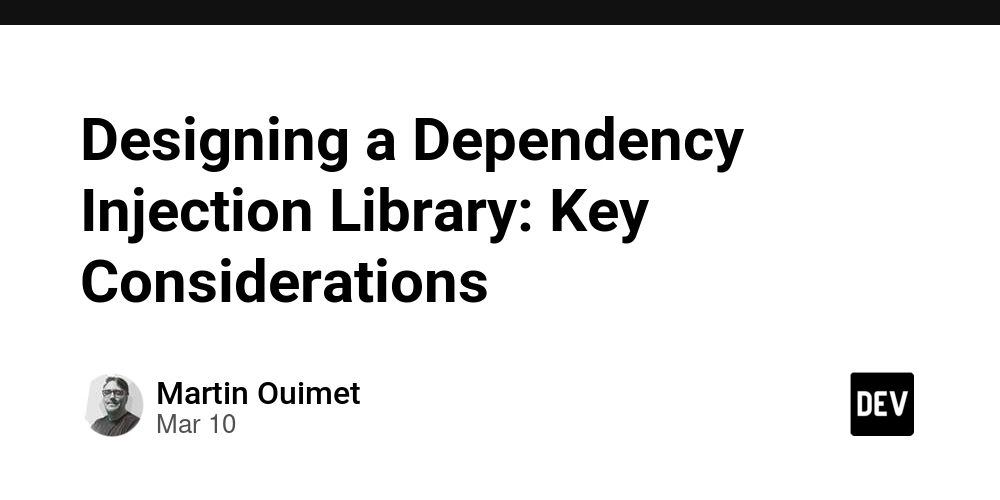Designing a Dependency Injection Library: Key Considerations
Designing a Dependency Injection Library: Key Considerations March 14, 2024dependency-injectionbrainstackinjecttypescriptarchitectureArchitecturePart 5 of the @brainstack/inject Series Part of @brainstack/inject Series View full series → Designing a Dependency Injection Library: Key Considerations Designing a dependency injection (DI) library involves several key considerations to ensure it is robust, flexible, and easy to use. In this article, we will explore the essential aspects of designing a DI library. Key Considerations 1. Service Registration The DI library should provide a straightforward way to register services. This includes support for different service lifetimes (singleton, transient, scoped) and the ability to register services using class constructors, factory functions, or instances. 2. Dependency Resolution The library should be able to resolve dependencies automatically, ensuring that the correct instances are provided when needed. This involves handling constructor injection, property injection, and method injection. 3. Service Scopes Support for different service scopes is crucial. Singleton services should be shared across the entire application, while transient services should create new instances each time. Scoped services should be managed within specific containers or modules. 4. Hierarchical DI The library should support hierarchical DI, allowing for parent-child container relationships. This enables dependency management across different parts of the application or within a monorepo. 5. Testability The DI library should facilitate unit testing by allowing easy mocking and swapping of dependencies. This includes providing methods to reset the container and register mock services. 6. Performance Performance is an important consideration, especially for large applications with complex dependency graphs. The library should be optimized to minimize overhead and ensure fast dependency resolution. 7. Error Handling The library should provide clear and informative error messages when dependencies cannot be resolved or when there are circular dependencies. This helps developers quickly identify and fix issues. 8. Extensibility The DI library should be extensible, allowing developers to add custom behaviors or integrate with other libraries and frameworks. This includes support for custom decorators, middleware, and plugins. Best Practices 1. Keep It Simple Simplicity is key. The DI library should have a simple and intuitive API that minimizes boilerplate code and makes it easy for developers to use. 2. Use Decorators Decorators provide a clean and declarative way to register and inject services. Use decorators like @Service, @Inject, and @SingletonService to simplify service registration and dependency injection. 3. Document Everything Comprehensive documentation is essential. Provide clear and detailed documentation for all features and APIs, including code examples and best practices. 4. Test Thoroughly Thoroughly test the DI library to ensure it works as expected in different scenarios. This includes unit tests, integration tests, and performance tests. Conclusion Designing a dependency injection library involves several key considerations and best practices to ensure it is robust, flexible, and easy to use. By following these guidelines, you can create a DI library that simplifies dependency management and promotes code reusability, testability, and maintainability. In the next article, we will take a deep dive into the implementation of @brainstack/inject. Stay tuned for more!

Designing a Dependency Injection Library: Key Considerations
dependency-injectionbrainstackinjecttypescriptarchitectureArchitecturePart 5 of the @brainstack/inject Series
Part of @brainstack/inject Series
Designing a Dependency Injection Library: Key Considerations
Designing a dependency injection (DI) library involves several key considerations to ensure it is robust, flexible, and easy to use. In this article, we will explore the essential aspects of designing a DI library.
Key Considerations
1. Service Registration
The DI library should provide a straightforward way to register services. This includes support for different service lifetimes (singleton, transient, scoped) and the ability to register services using class constructors, factory functions, or instances.
2. Dependency Resolution
The library should be able to resolve dependencies automatically, ensuring that the correct instances are provided when needed. This involves handling constructor injection, property injection, and method injection.
3. Service Scopes
Support for different service scopes is crucial. Singleton services should be shared across the entire application, while transient services should create new instances each time. Scoped services should be managed within specific containers or modules.
4. Hierarchical DI
The library should support hierarchical DI, allowing for parent-child container relationships. This enables dependency management across different parts of the application or within a monorepo.
5. Testability
The DI library should facilitate unit testing by allowing easy mocking and swapping of dependencies. This includes providing methods to reset the container and register mock services.
6. Performance
Performance is an important consideration, especially for large applications with complex dependency graphs. The library should be optimized to minimize overhead and ensure fast dependency resolution.
7. Error Handling
The library should provide clear and informative error messages when dependencies cannot be resolved or when there are circular dependencies. This helps developers quickly identify and fix issues.
8. Extensibility
The DI library should be extensible, allowing developers to add custom behaviors or integrate with other libraries and frameworks. This includes support for custom decorators, middleware, and plugins.
Best Practices
1. Keep It Simple
Simplicity is key. The DI library should have a simple and intuitive API that minimizes boilerplate code and makes it easy for developers to use.
2. Use Decorators
Decorators provide a clean and declarative way to register and inject services. Use decorators like @Service, @Inject, and @SingletonService to simplify service registration and dependency injection.
3. Document Everything
Comprehensive documentation is essential. Provide clear and detailed documentation for all features and APIs, including code examples and best practices.
4. Test Thoroughly
Thoroughly test the DI library to ensure it works as expected in different scenarios. This includes unit tests, integration tests, and performance tests.
Conclusion
Designing a dependency injection library involves several key considerations and best practices to ensure it is robust, flexible, and easy to use. By following these guidelines, you can create a DI library that simplifies dependency management and promotes code reusability, testability, and maintainability. In the next article, we will take a deep dive into the implementation of @brainstack/inject.
Stay tuned for more!











































































































































































![[The AI Show Episode 142]: ChatGPT’s New Image Generator, Studio Ghibli Craze and Backlash, Gemini 2.5, OpenAI Academy, 4o Updates, Vibe Marketing & xAI Acquires X](https://www.marketingaiinstitute.com/hubfs/ep%20142%20cover.png)




























































































































![[DEALS] The Premium Learn to Code Certification Bundle (97% off) & Other Deals Up To 98% Off – Offers End Soon!](https://www.javacodegeeks.com/wp-content/uploads/2012/12/jcg-logo.jpg)


![From drop-out to software architect with Jason Lengstorf [Podcast #167]](https://cdn.hashnode.com/res/hashnode/image/upload/v1743796461357/f3d19cd7-e6f5-4d7c-8bfc-eb974bc8da68.png?#)








































































































.png?#)























.webp?#)










_Christophe_Coat_Alamy.jpg?#)
 (1).webp?#)




































































































![Apple Considers Delaying Smart Home Hub Until 2026 [Gurman]](https://www.iclarified.com/images/news/96946/96946/96946-640.jpg)
![iPhone 17 Pro Won't Feature Two-Toned Back [Gurman]](https://www.iclarified.com/images/news/96944/96944/96944-640.jpg)
![Tariffs Threaten Apple's $999 iPhone Price Point in the U.S. [Gurman]](https://www.iclarified.com/images/news/96943/96943/96943-640.jpg)



































































































































